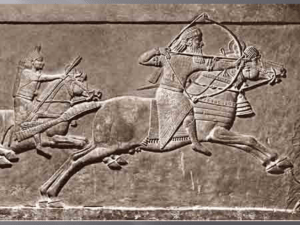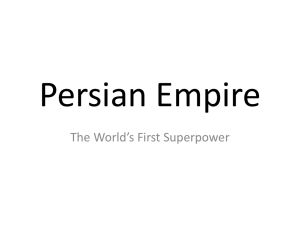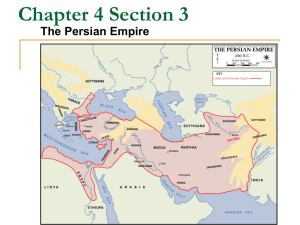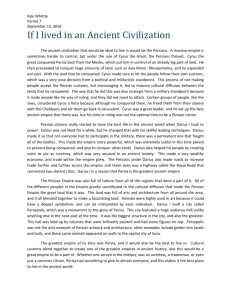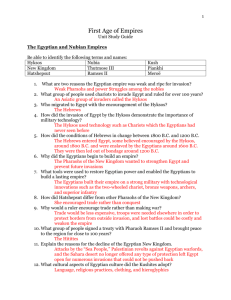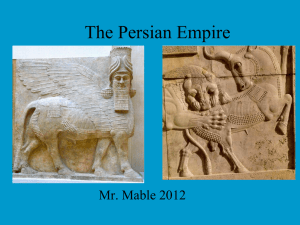Docx
advertisement
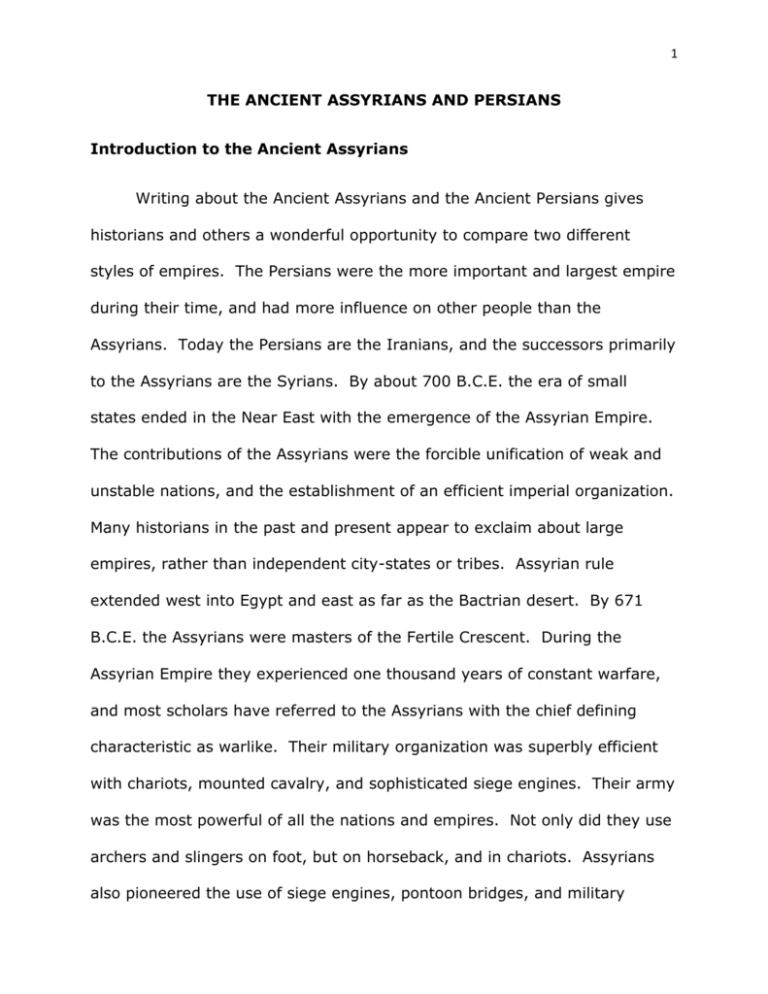
1 THE ANCIENT ASSYRIANS AND PERSIANS Introduction to the Ancient Assyrians Writing about the Ancient Assyrians and the Ancient Persians gives historians and others a wonderful opportunity to compare two different styles of empires. The Persians were the more important and largest empire during their time, and had more influence on other people than the Assyrians. Today the Persians are the Iranians, and the successors primarily to the Assyrians are the Syrians. By about 700 B.C.E. the era of small states ended in the Near East with the emergence of the Assyrian Empire. The contributions of the Assyrians were the forcible unification of weak and unstable nations, and the establishment of an efficient imperial organization. Many historians in the past and present appear to exclaim about large empires, rather than independent city-states or tribes. Assyrian rule extended west into Egypt and east as far as the Bactrian desert. By 671 B.C.E. the Assyrians were masters of the Fertile Crescent. During the Assyrian Empire they experienced one thousand years of constant warfare, and most scholars have referred to the Assyrians with the chief defining characteristic as warlike. Their military organization was superbly efficient with chariots, mounted cavalry, and sophisticated siege engines. Their army was the most powerful of all the nations and empires. Not only did they use archers and slingers on foot, but on horseback, and in chariots. Assyrians also pioneered the use of siege engines, pontoon bridges, and military 2 schools. Their policy of terrorization that included flaying their enemies while alive and decorating their buildings with human skin drove relentless fear of them. Political and military aspects of the Ancient Assyrians They had an efficient system of political administration, support of the commercial classes who wanted political stability and unrestricted trade over large areas. They built superb roads between cities and provincial capitals, which later was added to by the Persians, who named it the Royal Road. Another policy of the Assyrians was deportation on a large scale that was used to prevent the conquered people from revolting. In the Book of Esther in the Old Testament account of one deported Hebrew community is a fairly typical inscription from one of the Assyrian ruler’s monument that says: “From some [of my defeated enemies] I cut off their noses, their ears and their fingers. Of many I put out the eyes . . . I bound their heads to tree trunks round about the city . . . “There are many more stories in the Old Testament relating to the Assyrians and their various rulers like Sennacherib. Conquered lands became provinces ruled by governors who exercised extensive military, judicial, and financial powers. Their chief tasks were to ensure the regular collection of tribute and raising of troops for the permanent Assyrian army. Assyrians are credited with laying the foundations for later more humane administrative systems of their successors, the Persians, and Alexander the Great and his successors. 3 Assyrian kings such as Ashurbanipal, Sennecerib, and Sargon II were interested in preserving written as well as pictorial records of their reigns. King Ashurbanipal (ruled 668-626 B.C.E.) left a stunning record of his efforts in collecting the literary heritage of Sumer and Babylon in his monumental library at Nineveh, the capital. When it was destroyed later, all the thousands of clay tablets were preserved, and much of our knowledge of the ancient Mesopotamians and others comes from these artifacts that modern scholars have deciphered including the oldest copy of the Epic of Gilgamesh. While the indigenous Assyrians were generally not creative artisans, with the tribute collected from those they conquered, they were able to hire or enslave the best artists and architects to build monuments, statues, and palaces to glorify their kings. Much of the remains are in bas-reliefs showing their rulers as warriors or hunters. Hunting was a royal past time, and the artisans were especially good at showing the death throes of wounded animals in their hunting scenes. Their royal way of hunting was to send out lots of slaves with flails to beat the bushes, and to drive the game back to wherever the king was. Then the king would kill the terrified animal with a bow and arrow or spear, proving what a great warrior/hunter he was. Downfall of the Ancient Assyrians Eventually the Assyrians’ obsession with war backfired as the casualties of their native troops and nobles greatly increased. After three hundred years of rule, two of the conquered peoples, the Medes in the 4 Northeast and the Chaldeans in the South joined forces and revolted against the Assyrians. The Scythians also fought the Assyrians. The Chaldeans were a new group of Semitic speakers occupying Babylonia and the Medes were Indo-European speakers living further north and east. The first sign of revolt against the Assyrians occurred when the Medes refused to pay their annual tribute of slaves, horses, and money. Then the Chaldeans made an alliance with the Medes. After fourteen years of fighting in 612 B.C.E. the two groups conquered the Assyrians, destroying Nineveh completely. As the Bible says: “Nineveh is laid waste; who will bemoan her? “ 1 Conflict of Many Tribes for Control For the next fifty years approximately, four separate states struggled to gain control over the remains of the Assyrian Empire. The Egyptians and the Chaldeans fought to control Syria and Palestine and the Medes struggled with the Lydians for control of Mesopotamia and the trade route east to India. Lydians were Indo-Europeans and part of the wave of invaders who displaced the Hittites, occupying Anatolia on the shores of the Aegean Sea. The Medes with their capital at Ecbatana controlled the Persians at the time of the Assyrian conquest. Both the Medes and the Persians spoke the same Indo-European language called Fars of Farsi, which is still spoken in Iran today. The Medes were able to halt Lydian expansion, but their rule was short-lived, about fifty years when they were conquered by the Persians. 1 Nahum 3:7 5 The Rise of the Persians under Cyrus Through toleration not military terror the Persians came to rule a vast area, and is considered the first largest empire. It was in 550 B.C.E. that Cyrus, King of the Persians led an army against the Medes, and drove out the royal family from Ecbatana. When it became clear that Cyrus was not going to treat the Medes like conquered people but as subjects and equal to the Persians themselves, the Medes flocked to support him. This new Empire was known as the Achaemenid Empire, and lasted until 330 B.C.E. When the Lydians again tried to cross the Halys River successfully and invade Median territory, Cyrus defeated Croesus, the King of Lydia. Cyrus kept going and conquered all the adjacent kingdoms too. Next he turned east, pushing his armies as far as the Punjab in Modern India, and established the stable provinces of Parthia and Bactria. Finally, Cyrus turned south, conquering the Chaldeans and the entire basin of the Tigris and Euphrates Rivers. These successful conquests made Cyrus the greatest conqueror in history of the Ancient Near East. He ruled for twenty years and is usually referred to as Cyrus the Great. Not only was he a superb general, but by being firm but fair won the allegiance of the people he conquered. According to the second book of Isaiah in the Old Testament, Yahweh spoke of Cyrus as his servant. Cyrus was remarkably tolerant for his time and treated the Hebrews very well. He released the Jews from Babylon, and even helped fund the building of the Second Temple in Jerusalem. Realizing 6 how important religion was to the people he conquered, Cyrus, while a Zoroastrian like most Persians at the time, treated religious leaders in his huge empire with courtesy and consideration. The cooperation of these people was Cyrus’ reward. Cambyses and Darius One of Cyrus’ sons, Cambyses (ruled 530-22 B.C.E.) conquered Egypt, receiving the approval of the Egyptian priesthood, and became Pharaoh and theoretically owner of all the land. Consequently, Egypt contributed a lot of wealth to the Persian Empire. Darius the Great (521-486 B.C.E.) became the next ruler. While not Cambyses’ son, Darius married several of Cyrus’ daughters to ensure the legitimacy of his royal title. Darius proceeded to conquer new territory, as far east as the Indus River in India and as far north as the Danube River, but he could not control the Greeks. Greeks rebellion and war against the Persians The city-state of Athens defied him, refusing to pay tribute, and the Athenian colonies on the western coast of Asia Minor rose in rebellion. Darius had to punish Athens or lose face and thus the period in history known as the Persian Wars began. Next to the Bible, the Greek historian Herodotus’ History of the Persian Wars was the best written source of information. Darius created a huge multinational army, crossing the Hellespont on pontoon bridges, and made his way northward and then 7 westward. At the Battle of Marathon the Persians were defeated by the Athenian Army. Darius withdrew, and began preparations for another expedition against the Greeks. Then Darius died and his son Xerxes (ruled 486-465 B.C.E.) succeeded him. The famous battle at the pass at Thermopile and then the Battle of Salamis, forced the losing Persians out of Greece and western Asia Minor. While the Persians were never able to conquer the Greeks, they conquered practically everyone else, and the Persians continued to be a great power in Asia Minor and the Near East for another century, until Alexander the Great conquered them. Infrastructure and governance of the Persian Empire The Persian Empire was the first to attempt to govern many different racial groups on the principles of equal responsibilities and rights for all peoples. As long as their subjects paid their taxes and kept the peace, the Persian kings did not interfere with their local religion, customs, or trade. Dividing their empire into twenty provinces, the Persians produced an efficient organization of a large empire. Each province was ruled by an appointed civilian governor called a satrap. Satraps were usually drawn from the King’s family or from old Persian and Median nobility. To keep the Satraps honest, the central government sent out a secretary and military inspector to each satrapy. Additionally, special roving inspectors called the king’s eyes and ears also travelled throughout the empire. Tax collectors made up the third major portion of this efficient government apparatus. To 8 make all that travelling easier for merchants, soldiers, and government agents, the Persians added excellent roads to the Assyrian ones. There was a post station on some roads every fourteen miles. At these post stations the king’s messengers could get fresh horses, and cover sixteen hundred miles a week. The familiar words: “Neither snow nor rain nor heat nor gloom of night stays these courtiers from swift completion of their appointed rounds” was adopted by the United States Post Office. Persian Kingship Many historians blame Darius for the peculiar feature of Persian rule that Alexander the Great and later Roman Emperors adopted the idea of divine kingship. In Cyrus’ time the King of Persia was just a powerful king, but Darius and Xerxes and their successors isolated themselves from contact with ordinary people, and developed a form of court ritual, making it seem as if the king was a god. People who approached the king beginning with Darius unless they were very privileged advisors had to prostrate themselves flat on the floor. The Persians kings had absolute power of life and death over all their subjects, but in reality the kings cared about justice and fairness. They believed that they were the representatives of Ahura Mazda on earth. In the Hallelujah Chorus of Handel’s Messiah, the words for the singers call God “King of Kings, Lord of Lords.” These were titles attributed to the Persian kings or emperors. At Persepolis, Darius built his winter palace, while maintaining his administrative capital of Susa. Another one of 9 Darius’ building projects was the First Suez Canal, built to facilitate trade between Egypt and India with important stops for incense, myrrh, and wine along the coast of Arabia. Actively encouraging trade, Darius introduced the Lydian system of coinage with gold and silver coins throughout his empire. Persian Religious Beliefs - Zoroastrianism Like the ancient Jews, the religion of the Persians deviated sharply from the other Near Eastern religious traditions. Zoroastrianism became the dominant faith for the Persians. Its founder was Zoroaster, whose exact dates cannot be verified and range thousands of years apart, but most scholars place him around the sixth century B.C.E. At this time Persian religious practices were in the hands of a class of priests called Magi, who presided over the ritual worship of various deities, and the forces of nature, notably fire. They had a distinctive style of dress and lived rather austere lives. Deeply interested in astronomy the Magi used it for religious reasons. Some scholars think that the Magi were actually a specific clan or tribe like the Levites in the Hebrew Bible, but they became a ruling class or caste as the Brahman priests did in India. Most Persian rulers had a resident Magus (one Magi) to advise them. Zoroaster wanted to replace the ritualistic, idol worshipping cults and magi with a more ethical and philosophical way of looking at things. Zoroaster believed in one god, Ahura Mazda. His name means wise lord. He was a god of light who would take believers to paradise after their death if they practiced: “good thoughts of the mind, good deeds 10 of the hand, and good words of the tongue.” The English word paradise is the Persian word for garden. Many of our traditional ideas of Paradise derive from Persian descriptions. After Zoroaster’s death, the Magi took control of the religion, adding many rituals and replacing one god with what is referred to as philosophical dualism or more gods. Ahura Mazda became the god of light and goodness and he was locked in a battle with Ahriman, the god of darkness and evil. Zoroastrian scriptures were called Avesta, meaning law. They were not written down in their present form until a thousand or so years after Zoroaster. Additional doctrines of the resurrection of the dead, the last judgment influenced Judaism. Later, the Emperor Artaxerxes II named two other deities, Anahita, the goddess like Artemis, and Mithra, the god of the sun. Later, Mithraism was its own religion and become popular with Roman soldiers. Conclusion of Ancient Assyrians and Persians The Assyrian Empire can be thought of as sort of a dress rehearsal for the Persian Empire. While the Assyrians unified Asia Minor, they did so by brute force, and governing by terror. They were remembered with hatred by people they conquered. The Persians took over the territory of the Assyrians and expanded it in every direction. Borrowing many Assyrian military techniques, the Persians conquered, but they also had a strong sense of justice and toleration of other people’s cultures and religions. Mostly the Persian Empire benefitted the people it ruled, and even after Alexander the 11 Great conquered the Persian Empire, Persia continued to be the center of wealth, culture, and learning. Persian religious ideas influenced the Hebrews, the Greeks, the Romans, and the early Christians. One of the permanent contributions of the Persians to world civilization is the lifestyle of the rich and famous.
